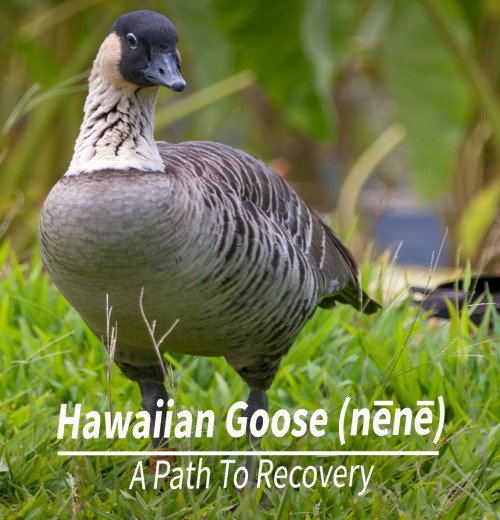
Photo caption: Recovery of endangered or threatened animals and plants is a primary goal of the Endangered Species Act. Conservation agencies and private landowners have made it possible to reestablish a population of nene once again in Hawaii. Photo credit: USFWS Pacific Islands Conservation & Restoration Team.
Hawaii’s State Bird is on the Road to Recovery
Nene proposed for downlisting from endangered to threatened thanks to strong local partnerships.
News Release from USFWS Pacific Region, March 30, 2018
After 60 years of collaborative conservation efforts among federal, state, non-governmental organizations, and local partners, the Hawaiian Goose, or nene , may be one step closer to recovery. An intensive captive breeding program, habitat restoration, and active management strategies have led to the nene return from the brink of extinction. As a result, the U.S. Fish and Wildlife Service has proposed downlisting the nene from endangered to threatened under the Endangered Species Act (ESA).
“It took decades of hard work and remarkable partnerships to bring nene back from the brink of extinction,” said Robyn Thorson, Regional Director for the Service’s Pacific Region. “Collaborative conservation efforts like this are the key to success in protecting and recovering Hawaii’s native species.”
One of the pressures that nene face are invasive species. Introduced invasive predators like mongooses, rats, dogs, cats and pigs all were factors that led to the first substantial declines of nene . Nene are highly vulnerable to predation when nesting. During nesting season, nene molt their feathers and are flightless making them easy prey for predators. Ongoing predator control, habitat management efforts, and collaborative conservation will continue to be important for nene to continue on the road to recovery.
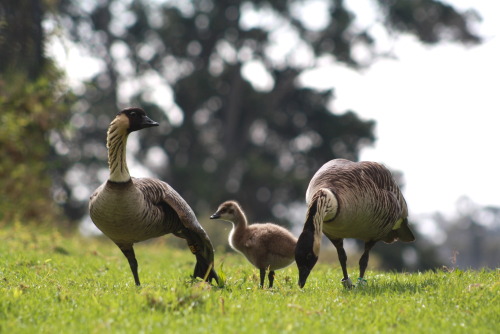
Photo caption: Nēnē can now be seen on both public and private lands throughout the Hawaiian Islands. Photo credit: Kathleen Misajon/NPS
By the mid-twentieth century, fewer than 30 nene remained in the wild on a small area on the island of Hawai‘i. A further 13 birds survived in captivity. The nene was listed as an endangered species in 1967, and in the decades following, some 2,800 captive-bred birds were released at more than 20 sites throughout the main Hawaiian Islands. The release of captive-bred nene on national wildlife refuges, national parks and state and private lands saved the species from imminent extinction.
Captive breeding has contributed to the ongoing recovery of nēnē throughout the Hawaiian Islands. The captive propagation of nene was a multi-tier effort that involved national and international conservation agencies.
The State of Hawaii, Peregrine Fund, Waterfowl and Wetland Trust, San Diego Zoo and private landowners all recognized the possibility of a potential nēnē extinction. Each of their captive breeding programs helped preserve the species and aided conservation managers with the recovery effort and eventual release of nēnē back into the wild.
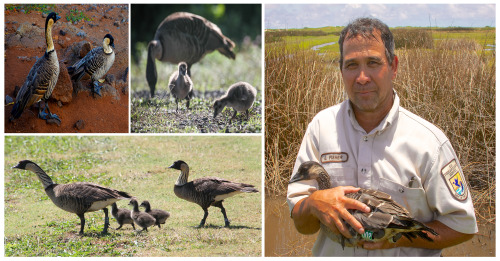
Photo caption: 2,800 captive-bred birds were released at more than 20 sites throughout the main Hawaiian Islands. Photo credits: USFWS
Today more than 2,800 individuals survive, with stable or increasing populations on Kauai, Maui and Hawaii Island and an additional population on Molokai.
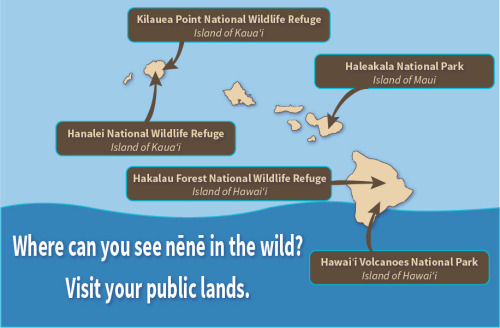
As nene increase in numbers and expand their range, they face increased interaction and potential conflict with landowners and businesses. In addition to the downlisting, the Service is proposing a rule that would allow additional flexibility for landowners to manage nene on their property. This rule, under section 4(d) of the ESA, allows some types of actions that are normally prohibited under the ESA as long as those actions are consistent with conservation of the nēnē. If the proposed downlisting is finalized, the rule would give landowners management flexibility without reducing the effectiveness of conservation actions or the recovery of the species.
Establishing a healthy population of nene in Hawaii requires flexibility, support and partnership with private landowners. Working with private landowners helps conservation managers maintain nene populations on both public and private lands. Private landowners like the Shipman Ranch allow for greater conservation management of nene on their land and neighboring release sites.
To further strengthen the connection with the community, the Service signed a Memorandum of Agreement with the U.S. Department of Agriculture’s National Resources Conservation Service (NRCS). Partners like Shipman Ranch and NRCS creates an innovative collaboration between the Service and private landowners that will benefit the nēnē recovery effort.
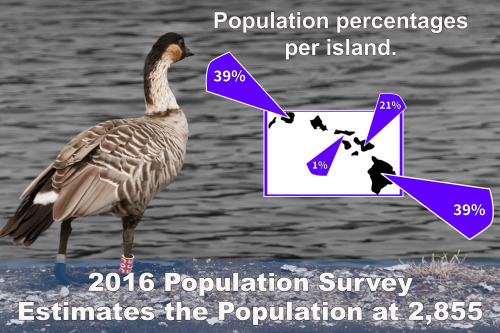
Photo caption: Visitors, birders and conservation enthusiasts can see Hawaii’s state bird on the Hawaiian Islands of Kauai, Molokai, Maui, and Hawaii. Photo credit: USFWS Pacific Islands Conservation & Restoration Team.
The State of Hawaii is an essential partner in the recovery of nene , helping lead the way with innovative conservation efforts, including the formation of the nene Recovery Action Group. This group is comprised of experts from state and federal agencies and has an important role in identifying nene conservation actions and priorities.
Collaboration is the key to success in recovering imperiled wildlife. The Service is actively working with diverse partners to conserve imperiled species and to work toward fully recovering them so they can be removed from listing under the ESA. Downlisting species as they meet their recovery goals ensures we are continuing to use our resources to protect the most at-risk species.
The Service is seeking your comments. Find out more below.
For more information about the nene and to view the proposal and instructions on how to submit comments, visit www.fws.gov/pacificislands.
All relevant comments received from April 2 - June 1, 2018, will be considered.
Looking for more nene photos and videos, visit: https://goo.gl/fW93iU
All comments and materials we receive become part of the public record associated with this action. Before including an address, phone number or other personal identifying information in comments, the public should be aware that the entire comment—including personal identifying information—might be made publicly available at any time.